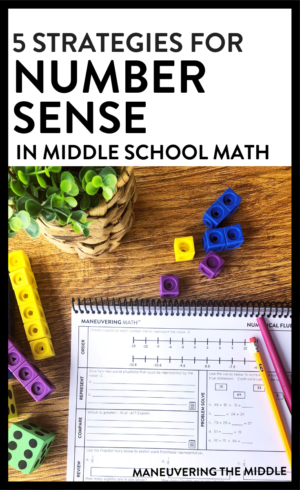Last week, I shared my love for the book Developing Numerical Fluency and broke down the idea of number sense. This week, I wanted to share five strategies for building number sense in the middle school classroom. Upon preparing for this blog post, I did quite a bit of research and was disappointed to see that the vast majority of books on numerical fluency are geared towards K-5 educators. While I see the importance of a strong foundation, I do see the need for teachers to fill gaps and bring students up to the grade-level standards.
Looking for more math intervention ideas? Check out this page.
5 Strategies for building Number sense in Middle School Math

1. Utilizing Fraction Bars
Fractional parts can be such a tough concept for kids. They really need to “see” the pieces and understand how they work together. I love this set of fraction bars because they are large and can be seen across the room. Your math department needs to have a set of fraction bars, fraction circles, etc. so that each math class has one. This will be impactful as students learn to visualize each problem and use the most efficient method of solving.
2. Doubling and Halving
When students are able to quickly double and half a number, they are more successful with various operations and less likely to get bogged down in the details of the algorithm.
For example, when a student knows that 1.75 can be doubled to 3.5 and then doubled again to become 7, they are more likely to see the relationship in the table and the constant of proportionality.
When a table begins with an x-value of 2, they are more likely to find y when x=1 efficiently if they are able to halve the y-value.
3. Visualizing ½
One-half is a huge benchmark value for middle school students. Is the value greater than or less than ½? Is the value closer to ½ or 1? By simply being able to answer those questions, often students are able to eliminate wrong answers and problem-solve using estimation and reasonableness.
When given a number line are they able to identify ½ of the number line? One-half of the two numbers given? Or even just see the number line in various parts? If you can find ½, then you can also find ¼ and ¾.
4. Incorporating Area Models
It wasn’t until I watched Jo Boaler’s video on number sense that I truly understood the value of the area model. Sure, it makes sense in elementary school as an array, but it has so many applications in middle school!
- multiplication of whole numbers
- multiplication of fractions and decimals
- area of a two-dimensional object
- the distributive property
I love how the area model is fluid and open-ended with various correct answers.
5. Utilizing Friendly Numbers
When students struggle, I really try to incorporate the use of friendly numbers. I cannot tell you how many times I have seen a struggling student try to find 35% of $24.99. Let’s go with 35% of $25…it is sooo close! I am sure I am not the only one who has seen students struggle with 3.14 as pi. There is a time and a place for accuracy and precision, but when students are struggling, it is difficult to determine if they are struggling with finding the percent of a number or if they are getting lost in their math.
Let me know what other strategies for building number sense that you have found useful in the comments below
Click to find out more about Maneuvering Math™.



